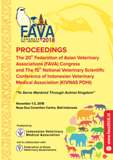VPH-2 Risk Factor Analysis for the Transmission of Classical Swine Fever in West Timor, Indonesia
Abstract
Classical Swine Fever (CSF) is a serious and highly infectious viral disease of domestic pigs and wild boar (Paton and Greiser-Wilke 2003). The causative agent, Classical Swine Fever Virus (CSFV) is a small (40±60 nm) enveloped ribonucleic acid (RNA) virus with a single stranded genome with positive polarity (Horzinek et al. 1971; Moennig and Greiser-Wilke 2008). The virus is one of three pestiviruses that forms a group of economically important pathogens (Moennig et al. 1990) belonging to the Flaviviridae family. It has a close antigenic relationship with the other pestiviruses - bovine viral diarrhoea virus (BVDV) and border disease virus (BDV), as demonstrated by immunodiffusion and immunofluorescence tests, and their similar morphology and nucleic acid homology (Wengler 1991; Wengler et al. 1995). Indonesia was free from CSF until 1993. Between 1994 and 1996 thousands of pigs were reported to have died from the disease in the Indonesian regions of North Sumatera, Jakarta, Bali, Central Java, and North Sulawesi (Satya and Santhia 2000). An outbreak of CSF was reported in Dili, East Timor in August 1997 and the disease then spread to the Kupang district of West Timor in March 1998 (Satya and Santhia 2009) and subsequently to all districts of Timor (Santhia et al. 1997; Santhia et al. 1998).
The existence of CSF in an area and the potential for introducing the disease into a new area can be associated with the presence of certain risk factors. Identification of these risk factors is important in understanding the transmission of disease and for developing effective prevention, control and eradication programs. Farmers are a valuable source of information about potential risk factors and associated management and husbandry practices linked with disease as they often have many years of experience in raising or trading livestock. This knowledge can be used to identify risk factors for disease.
The objective of the study was to identify potential risk factors associated with CSF infection in West Timor. In particular factors involved in the management and husbandry of pigs were investigated.

